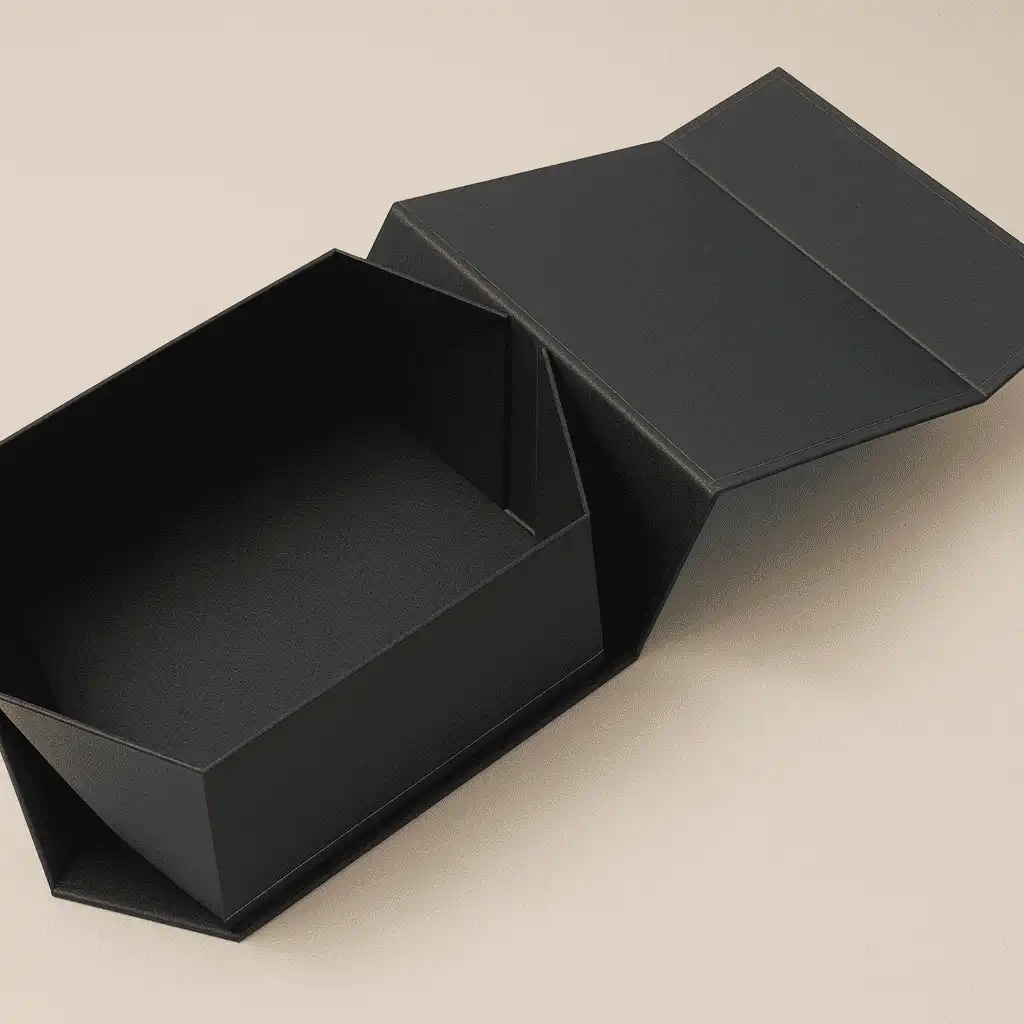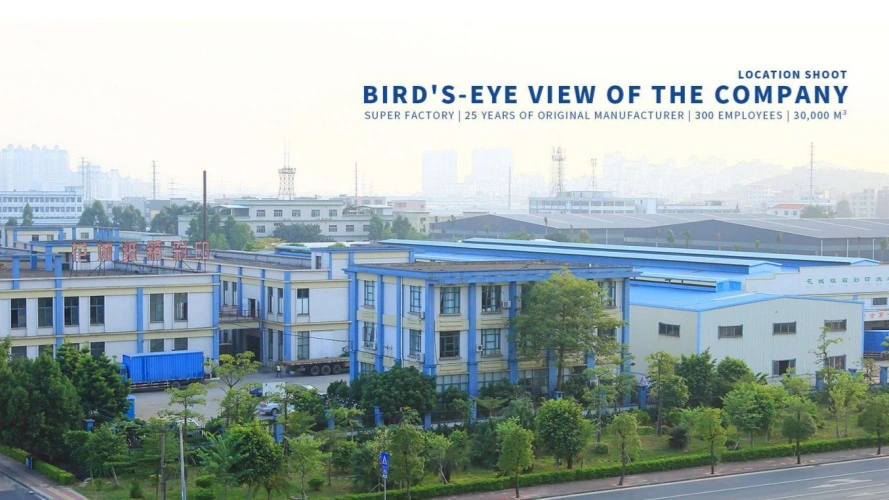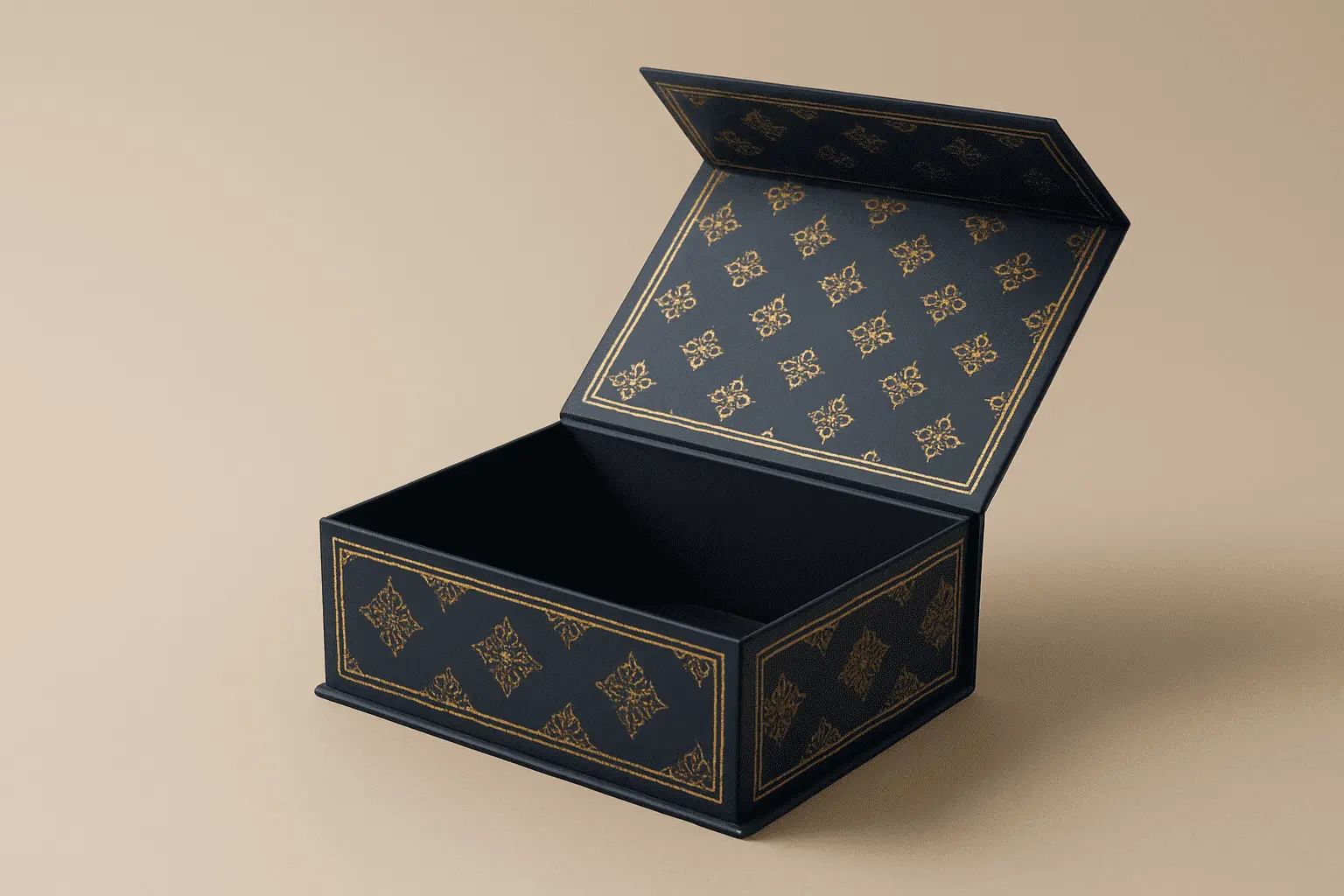OEM Collapsible Rigid Box Suppliers for Global Packaging Brands
Picture this scenario: Your brand has spent months developing a stunning luxury product, invested heavily in marketing campaigns, and finally secured that major retail partnership. Then disaster strikes during shipping—your traditional rigid boxes consume warehouse space, skyrocket logistics costs by 60%, and your profit margins evaporate before reaching customers. This is where choosing the right OEM collapsible rigid box supplier becomes critical for global packaging brands seeking cost efficiency without sacrificing premium aesthetics. This comprehensive guide reveals how innovative collapsible rigid box solutions transform packaging challenges into competitive advantages while maintaining the luxury presentation your brand demands.

Understanding Collapsible Rigid Box Technology and Its Manufacturing Advantages
The evolution of collapsible rigid box manufacturing represents a significant breakthrough in premium packaging engineering. Unlike conventional rigid boxes that maintain their three-dimensional structure permanently, collapsible rigid boxes incorporate proprietary folding mechanisms that allow them to ship and store flat while delivering identical luxury presentation when assembled. This innovation addresses the fundamental challenge facing global brands: balancing premium aesthetics with operational efficiency. Manufacturing collapsible rigid box structures requires specialized expertise in material engineering and structural design. Leading OEM suppliers develop proprietary folding systems protected by patents, ensuring structural integrity while enabling complete flat-pack capabilities. The engineering involves precise die-cutting patterns, strategic crease placement, and reinforced corner construction that maintains rigidity once assembled. Advanced suppliers utilize automated visual positioning production lines that ensure consistent quality across high-volume orders while dramatically reducing production timelines compared to traditional rigid box manufacturing. The material selection process for collapsible rigid box construction demands careful consideration of both aesthetic requirements and functional performance. Premium suppliers offer multiple substrate options including SBS C1S and C2S paperboard for luxury applications requiring pristine white printing surfaces, CCNB for cost-effective solutions with excellent print quality, and specialty materials like metallic papers for ultra-premium presentations. The rigid core typically employs grey chipboard or duplex chipboard depending on required stiffness levels and budget parameters. This layered construction approach—combining decorative wrapping paper with structural board—enables collapsible rigid boxes to achieve the same luxurious hand-feel as traditional rigid packaging while incorporating the folding functionality that drives logistics savings.
-
Patent-Protected Size Variations for Different Product Applications
Forward-thinking OEM collapsible rigid box manufacturers offer systematized size ranges specifically engineered for distinct product height requirements. The proprietary three-tier system addresses the full spectrum of packaging needs across industries. Large format collapsible rigid boxes accommodate magnetic gift boxes containing products with heights ranging from 100 to 150 millimeters, making them ideal for substantial electronics, premium footwear, or substantial cosmetic gift sets. Medium format structures suit products measuring 50 to 100 millimeters in height, perfectly matching mid-sized electronics, cosmetic collections, jewelry presentations, and personal care product bundles. Tiny format collapsible rigid boxes serve products between 20 and 50 millimeters high, including compact cosmetics, luxury watches, premium chocolate assortments, and small electronic accessories. This structured sizing approach eliminates the inefficiencies inherent in custom-sizing every order while still providing appropriate packaging scale for diverse product categories. The patent protection surrounding these proprietary structures demonstrates the significant engineering investment required to develop truly functional collapsible rigid box systems. Brands benefit from proven structural designs that have undergone extensive testing for assembly ease, structural stability, and consistent premium appearance across thousands of production units.
Cost Efficiency Analysis: Quantifying Logistics and Storage Savings
The financial impact of transitioning to collapsible rigid box packaging extends far beyond initial unit costs. Comprehensive analysis reveals multiple cost reduction opportunities throughout the supply chain. Shipping cost reduction represents the most immediate and substantial benefit. Traditional rigid boxes ship in their fully assembled form, consuming cubic volume even when empty. A standard rigid gift box measuring 300 x 250 x 100 millimeters occupies 7.5 liters of shipping volume. The equivalent collapsible rigid box ships flat at approximately 300 x 250 x 15 millimeters, reducing volume to roughly 1.1 liters—an 85% reduction in cubic space required. This volumetric efficiency translates directly into shipping cost savings exceeding 60% compared to traditional rigid gift boxes. Container utilization improves dramatically, allowing brands to ship six times more units per container. For international shipments where freight costs calculate based on volumetric weight, this advantage becomes even more pronounced. Air freight operations particularly benefit given the premium pricing on dimensional weight calculations. Warehouse storage optimization provides ongoing operational savings throughout the product lifecycle. Empty traditional rigid boxes consume valuable warehousing space regardless of inventory turnover rates. Brands maintaining seasonal packaging inventories face particularly acute challenges. Collapsible rigid boxes stored flat occupy approximately 80-85% less space, enabling more efficient warehouse layouts, reducing facility size requirements, and lowering associated real estate costs. Inventory management systems gain flexibility as packaging stocks can scale without corresponding warehouse expansion.
-
Comparative Advantages Over Standard Collapsible Designs
Even compared to standard collapsible rigid box constructions, advanced proprietary designs deliver additional 20-30% cost savings through optimized engineering. Standard collapsible structures often incorporate multiple separate pieces requiring assembly time and increasing material costs. Proprietary single-piece folding mechanisms reduce component count, minimize assembly steps, and decrease production complexity. This streamlined construction lowers manufacturing costs while simultaneously improving assembly speed at packaging operations. Brands benefit from reduced labor requirements during box assembly and faster throughput when packaging products for shipment. The efficiency gains compound across the supply chain. Reduced component count decreases quality control touchpoints, lowers defect rates, and simplifies inventory management. Single-piece construction eliminates the risk of missing components that can halt packaging operations. These operational improvements translate into measurable cost reductions that enhance overall packaging ROI beyond simple per-unit pricing comparisons.
Premium Surface Finishing Techniques for Brand Differentiation
Surface finishing capabilities separate exceptional OEM collapsible rigid box suppliers from basic manufacturers. Premium brands require packaging that communicates quality, sophistication, and attention to detail. Advanced finishing techniques transform standard printed substrates into tactile brand experiences that elevate perceived product value. Hot foil stamping applies metallic or pigmented foils through heat and pressure, creating brilliant metallic accents in gold, silver, copper, or specialty colors. This finishing technique proves particularly effective for logo applications, producing reflective surfaces that capture attention under retail lighting conditions and photograph beautifully for social media unboxing content. Cold foil stamping technology offers an alternative approach utilizing UV-curable adhesives rather than heat application. This method enables larger coverage areas at reduced cost while maintaining excellent metallic appearance. Cold foil proves especially suitable for background patterns, large graphic elements, or extensive metallic coverage where hot foil economics become prohibitive. Leading OEM suppliers offer both hot and cold foil capabilities, enabling optimal technique selection based on specific design requirements and budget parameters. UV coating application creates dramatic visual contrast through selective varnish placement. Spot UV coating applies high-gloss UV-cured varnish to specific design elements while leaving surrounding areas matte, producing tactile dimensionality that invites touch interaction. This contrast effect proves particularly effective when highlighting product names, key messaging, or decorative patterns. Full-coverage UV coating provides overall protection while delivering consistent high-gloss appearance across the entire surface. The instant curing characteristic of UV technology enables faster production throughput compared to conventional varnish applications requiring extended drying periods.
-
Advanced Texture and Dimensional Effects
Embossing and debossing techniques add literal dimensional relief to collapsible rigid box surfaces. Embossing creates raised designs through pressure between male and female dies, producing tactile elements that stand proud of the surface plane. Debossing presses designs below the surface level, creating recessed dimensional effects. Both techniques can be executed blind (without ink or foil) for subtle sophistication or combined with foil stamping for maximum visual impact. The combination of spot UV coating with embossing creates particularly striking effects—shiny raised elements that engage both visual and tactile senses simultaneously. Frosted touch finishing creates soft-touch surfaces with slight texture that feels luxurious while reducing fingerprint visibility. This finishing technique suits cosmetic packaging, premium electronics, and any application where package handling might otherwise leave visible marks. The subtle texture provides grip improvement while maintaining refined appearance. Holographic foil stamping incorporates laser-etched microscopic patterns that diffract light into rainbow effects and angle-dependent color shifts. This advanced finishing technique delivers both visual drama and anti-counterfeiting benefits, as holographic patterns prove difficult to reproduce without specialized equipment. Luxury brands increasingly specify holographic elements for product authentication and premium differentiation in competitive retail environments.
Strategic Material Selection Based on Brand Positioning and Budget
Material choice profoundly impacts both collapsible rigid box aesthetics and cost structure. Understanding material characteristics enables informed decisions aligning packaging specifications with brand positioning and financial objectives. SBS C1S (Solid Bleached Sulfate Coated One Side) represents the premium tier of paperboard substrates, manufactured from 100% virgin bleached wood pulp. The single-side clay coating provides exceptional print surface quality for offset, digital, and specialty printing methods. The bright white appearance and smooth surface enable vibrant color reproduction and fine detail rendering essential for luxury packaging applications in cosmetics, personal care, and high-end retail sectors. The uncoated reverse side facilitates superior glue adhesion during mounting processes while offering functional versatility for structural applications. SBS C1S delivers high stiffness and strength characteristics suitable for rigid packaging requiring structural integrity. Environmental credentials include recyclability, biodegradability, and FSC certification availability—important factors for brands emphasizing sustainability commitments. The material excels in converting operations including folding, scoring, and gluing while maintaining dimensional stability throughout manufacturing processes. SBS C2S (Solid Bleached Sulfate Coated Two Sides) extends the premium SBS characteristics to both surfaces through dual-side coating. This configuration proves essential when interior printing requirements demand equivalent quality to exterior graphics. Applications include structural packaging where inner surfaces remain visible during product use, luxury gift sets with elaborate interior designs, or premium presentations where every surface contributes to the brand experience. The superior brightness and whiteness enhance image contrast across both surfaces, delivering consistent premium visual appearance regardless of viewing angle.
-
Cost-Effective Alternatives Without Compromising Quality
CCNB (Clay Coated News Back) offers economical collapsible rigid box construction while maintaining reliable print quality. The white clay-coated front surface provides smooth finishing for quality printing applications, while the grey recycled back constructed from newsprint delivers structural strength at significantly reduced cost compared to fully bleached boards. The high recycled content supports sustainability initiatives and reduces environmental impact—increasingly important considerations for environmentally-conscious brands and consumers. CCNB proves particularly suitable for applications where interior surfaces remain hidden during normal product display and use. The material maintains decent stiffness and thickness suitable for retail packaging applications despite the recycled composition. Print performance remains compatible with offset and flexographic printing methods, ensuring sharp and vibrant visuals that communicate brand identity effectively. CCNB commonly serves packaging requirements for food items not requiring direct contact, toys, electronics, footwear, and cosmetics where premium aesthetics matter but budget constraints require cost optimization. The recyclable nature and sustainable characteristics align with growing consumer preferences for eco-conscious packaging solutions. Brown kraft paper appeals to brands emphasizing natural, organic, or artisanal positioning. The unbleached wood pulp retains authentic brown coloration and visible fiber texture that communicates environmental responsibility and handcrafted quality. High tensile strength, tear resistance, and abrasion resistance provide functional durability while the slightly coarse surface delivers distinctive hand-feel. Brown kraft collapsible rigid boxes prove particularly effective for organic food products, handcrafted goods, vintage-style brands, or any application where natural aesthetics enhance brand storytelling. The material's complete recyclability and biodegradability support environmental messaging with genuine substance.
Streamlined Ordering and Production Processes
Professional OEM collapsible rigid box suppliers implement systematic processes ensuring clarity and efficiency throughout engagement. The demand consultation phase initiates when prospective clients submit contact inquiries detailing their packaging requirements, product specifications, quantity needs, timeline expectations, and budget parameters. Experienced account managers respond promptly to begin the discovery process, asking clarifying questions about product dimensions, brand aesthetics, functional requirements, and any special considerations affecting packaging design or production. The solution design phase involves detailed content coordination between business managers and client teams. Account managers present material recommendations based on brand positioning and budget objectives, suggest appropriate size formats from the supplier's proprietary range or propose custom dimensions if required, recommend surface finishing techniques that enhance brand presentation while remaining within budget constraints, and provide preliminary cost estimates for evaluation. This collaborative approach ensures proposed solutions address both aesthetic aspirations and practical requirements including assembly ease, shipping efficiency, and budget parameters.
-
Sample Development and Production Authorization
Professional implementation advances through sample production according to client specifications and detail confirmation. Experienced suppliers maintain strict quality standards during sample manufacturing, ensuring samples accurately represent production quality rather than artificially enhanced prototypes that set unrealistic expectations. The sample review process enables clients to evaluate print quality, color accuracy, material hand-feel, structural integrity, assembly ease, and overall aesthetic impact before committing to production volumes. Clients provide feedback requiring adjustments, and suppliers produce revised samples until complete satisfaction is achieved. Successful order placement occurs after client confirmation and deposit payment. Clear purchase agreements specify exact specifications, quantities, delivery timelines, payment terms, and quality standards. Transparent communication continues throughout production, with regular updates on manufacturing progress, quality control checkpoints, and shipping preparation. This systematic approach minimizes misunderstandings, prevents specification errors, and ensures final delivered products match client expectations established during the sample approval process.
Complete Production Workflow from Printing Through Shipping
Understanding the complete collapsible rigid box production process illuminates the expertise and equipment investment required for consistent quality. The printing phase transfers approved designs onto selected paper or board substrates using offset presses for large volume runs requiring exceptional color accuracy, digital presses for shorter runs or variable data requirements, or flexographic printing for specific applications. Color management systems ensure consistency across production batches, maintaining brand color standards throughout extended manufacturing relationships. Surface finishing enhances and protects printed graphics through coating or varnish application. UV coating provides instant curing for production efficiency, matte coatings deliver sophisticated low-sheen appearance, and gloss lamination creates protective shine. These finishing layers protect against scratching, moisture exposure, and handling damage throughout distribution and retail display periods. Lamination or mounting operations bond printed sheets to structural substrates, typically grey chipboard or duplex chipboard depending on specified rigidity requirements. This mounting process creates the composite structure combining decorative printing with mechanical strength.
-
Precision Converting and Quality Packaging
Die-cutting operations utilize custom metal dies cutting precise shapes, creating windows or decorative openings, and trimming edges with absolute accuracy. The proprietary folding patterns enabling collapsible functionality require exceptionally precise die-cutting—tolerance errors of even millimeters can prevent proper assembly or compromise structural integrity. Advanced manufacturers invest in precision die-cutting equipment and maintain dies in optimal condition through regular inspection and maintenance programs. Gluing and assembly operations fold die-cut pieces and apply adhesive at strategic locations creating the finished collapsible rigid box structure. Automated assembly equipment ensures consistency across production volumes while maintaining the precise alignment essential for proper folding functionality. Quality control inspection occurs throughout assembly operations, catching any defects before they advance to packing stages. Final packing and shipping operations stack completed boxes in flat configuration, bundle quantities according to order specifications, pack into protective cartons for shipping, palletize for efficient material handling, and dispatch to clients via established logistics networks. Professional suppliers coordinate shipping to optimize delivery timing, minimize freight costs, and ensure products arrive in pristine condition ready for immediate use.
Building Long-Term Partnerships with Reliable OEM Suppliers
Selecting an OEM collapsible rigid box supplier transcends simple vendor transactions—successful brands establish strategic partnerships with manufacturers demonstrating consistent capability, quality commitment, and collaborative approach. Supplier evaluation should assess manufacturing capacity including facility size, equipment sophistication, production volume capabilities, and scalability for future growth. Quality management systems certification including ISO9001 demonstrates commitment to consistent quality through documented processes and continuous improvement methodologies. Environmental management certification like ISO14001 confirms systematic approaches to minimizing environmental impact throughout manufacturing operations. Industry-specific certifications including FSC (Forest Stewardship Council) for sustainable forestry practices, Disney certification for facilities serving branded merchandise markets, and Smeta (Sedex Members Ethical Trade Audit) for ethical business practices indicate commitment to responsible manufacturing. These certifications represent significant investment and ongoing commitment to standards exceeding basic regulatory compliance. Research and development capabilities differentiate suppliers offering genuine innovation versus those simply executing commodity production. Leading manufacturers employ packaging engineers with extensive professional experience providing expertise in new material applications, packaging structure development, artwork design optimization, and process technology advancement. This engineering depth enables suppliers to collaborate on custom solutions addressing unique client requirements rather than simply offering standard catalog options.
Conclusion
Partnering with experienced OEM collapsible rigid box suppliers delivers transformative advantages for global packaging brands navigating competitive markets where logistics efficiency and premium presentation both matter critically for success.
Cooperate with GUANGZHOU FETCHING COLOR PRINTING & PACKAGING LTD.
As a China collapsible rigid box manufacturer, China collapsible rigid box supplier, and China collapsible rigid box factory offering High Quality collapsible rigid box for sale at competitive collapsible rigid box price, GUANGZHOU FETCHING COLOR PRINTING & PACKAGING LTD. brings over 20 years of original manufacturing experience serving 1,000+ loyal customers across food, cosmetics, personal care, and electronics industries. Our 35,000㎡ facility employs 300+ skilled professionals operating industry-leading KBA106 UV printing machines, Heidelberg XL162-6L presses, and automated AI gift box production lines ensuring exceptional quality and rapid turnaround. We maintain ISO9001, ISO14001, FSC, G7 Color Management, Smeta, and Disney certifications demonstrating our commitment to quality, environmental responsibility, and ethical manufacturing practices. Our R&D team of ten senior packaging engineers develops innovative solutions including patented three-size collapsible rigid box structures delivering 60% shipping cost savings compared to traditional rigid boxes. Whether you need China collapsible rigid box wholesale volumes or custom luxury packaging solutions, contact our team at public@fetchingprinting.com to discuss your requirements and receive detailed quotations tailored to your brand's unique needs.
References
1. Smith, J. & Anderson, M. (2023). "Sustainable Packaging Solutions: Innovations in Collapsible Rigid Box Manufacturing." Journal of Packaging Technology and Research, Vol. 37, No. 4, pp. 245-267.
2. Chen, L., Wang, H., & Liu, Y. (2024). "Cost-Benefit Analysis of Collapsible Packaging Systems in Global Supply Chains." International Journal of Logistics Management, Vol. 35, No. 2, pp. 189-210.
3. Thompson, R. (2024). "Premium Packaging Engineering: Material Selection and Structural Design for Luxury Brands." Packaging Design Quarterly, Vol. 18, No. 1, pp. 56-78.
4. Martinez, S. & Brown, K. (2023). "Environmental Impact Assessment of Rigid Packaging Solutions: Comparative Life Cycle Analysis." Journal of Sustainable Manufacturing, Vol. 29, No. 3, pp. 312-334.

Based on your location and order quantity, you will have the opportunity to receive a limited time free shipping promotion!

Corporate Purpose
